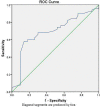Relationship between cartilage oligomeric matrix protein (COMP) and rheumatoid arthritis severity
- PMID: 29560145
- PMCID: PMC5843419
- DOI: 10.19082/5940
Relationship between cartilage oligomeric matrix protein (COMP) and rheumatoid arthritis severity
Abstract
Background: Serum cartilage oligomeric matrix protein (COMP) is a non-collagen glycoprotein produced by the cartilage, synovium, tendon, and meniscus. Recent studies showed that COMP is a reliable factor for monitoring cartilage damage.
Objective: To determine the relationship between serum COMP concentration and the severity of rheumatoid arthritis (RA).
Methods: This cross-sectional study lasted from 2013 to 2015 at the Rheumatology Clinic of Ghaem Hospital, Mashhad, Iran. The study population consisted of eligible patients who presented to our clinic during the study period. Four groups (150 subjects) were included as early RA (50 patients), late RA (50 patients), grades II and III OA (osteoarthritis) (25 cases, 17 grade II and 8 grade III joint destruction), and healthy controls (25 individuals). These were included consecutively. Serum COMP level was assessed by sandwich ELISA technique. In addition, ESR, hs-CRP, serum RF, and anti-CCP were assayed. X-rays of the knees (in OA) and hands (in RA) were examined for the degree of joint damage/erosion using the Short Erosion Scale (SES) in RA and Kellgren-Lawrence grading in OA. Analysis of variance (ANOVA) to compare mean COMP level among the groups and ROC (Receiver Operating Characteristic) analysis to determine the diagnostic accuracy of COMP in diagnosis of late RA were used by SPSS software (ver. 20.0).
Results: Mean (±SD) serum COMP levels were 18 (±10.6) U/L in early RA, 19.3 (±9.6) U/L in late RA, 10.9 (±4.5) U/L in OA, and 4.2 (±3.8) in controls; p<0.001. Serum COMP level was higher in RA and OA groups when compared to control group. Mean (±SD) SES score was 13.5 (±7.5) in early RA and 16.4 (±9.7) in late RA (p=0.093). There was a significant positive correlation between COMP level and disease severity in early RA (r=0.677, p<0.001) as well as in late RA (r=0.753, p<0.001). Serum COMP level at a concentration of 15.25 U/L had a sensitivity of 68% and specificity of 70% to discriminate late RA from early RA (area under curve= 69% (95% CI: 58% to 79%; p=0.001).
Conclusion: COMP had positive significant correlation with early and late RA severity. This serum biomarker can be a useful and easy tool for monitoring of RA patients either at early or late stages of the disease.
Keywords: Cartilage oligomeric matrix protein (COMP); Extracellular matrix proteins; Rheumatoid arthritis.
Conflict of interest statement
Conflict of Interest: There is no conflict of interest to be declared.
Figures
Similar articles
-
[Cartilage oligomeric matrix protein (COMP): the role of a non-collagen cartilage matrix protein as a marker of disease activity and joint destruction in patients with rheumatoid arthritis and osteoarthritis].Z Rheumatol. 1999 Apr;58(2):79-87. doi: 10.1007/s003930050156. Z Rheumatol. 1999. PMID: 10408068 German.
-
Serum cartilage oligomeric matrix protein (COMP) in rheumatoid arthritis and knee osteoarthritis.Clin Rheumatol. 2005 Jun;24(3):278-84. doi: 10.1007/s10067-004-1000-x. Epub 2004 Nov 18. Clin Rheumatol. 2005. PMID: 15940561
-
Cartilage oligomeric matrix protein (COMP) in rheumatoid arthritis and its correlation with sonographic knee cartilage thickness and disease activity.Clin Rheumatol. 2017 Dec;36(12):2683-2688. doi: 10.1007/s10067-017-3817-0. Epub 2017 Sep 9. Clin Rheumatol. 2017. PMID: 28889184
-
Correlation of serum cartilage oligomeric matrix protein with knee osteoarthritis diagnosis: a meta-analysis.J Orthop Surg Res. 2018 Oct 19;13(1):262. doi: 10.1186/s13018-018-0959-y. J Orthop Surg Res. 2018. PMID: 30340615 Free PMC article.
-
Cartilage oligomeric matrix protein, C-terminal cross-linking telopeptide of type II collagen, and matrix metalloproteinase-3 as biomarkers for knee and hip osteoarthritis (OA) diagnosis: a systematic review and meta-analysis.Osteoarthritis Cartilage. 2019 May;27(5):726-736. doi: 10.1016/j.joca.2018.10.009. Epub 2018 Nov 2. Osteoarthritis Cartilage. 2019. PMID: 30391538
Cited by
-
The quest for substrates and binding partners: A critical barrier for understanding the role of ADAMTS proteases in musculoskeletal development and disease.Dev Dyn. 2021 Jan;250(1):8-26. doi: 10.1002/dvdy.248. Epub 2020 Sep 17. Dev Dyn. 2021. PMID: 32875613 Free PMC article. Review.
-
Effects of Etanercept and Adalimumab on Serum Levels of Cartilage Remodeling Markers in Women with Rheumatoid Arthritis.J Clin Med. 2023 Aug 9;12(16):5185. doi: 10.3390/jcm12165185. J Clin Med. 2023. PMID: 37629227 Free PMC article.
-
Identification of age-related genes in rotator cuff tendon.Bone Joint Res. 2024 Sep 10;13(9):474-484. doi: 10.1302/2046-3758.139.BJR-2023-0398.R1. Bone Joint Res. 2024. PMID: 39253760 Free PMC article.
-
Cartilage Oligomeric Matrix Protein, Diseases, and Therapeutic Opportunities.Int J Mol Sci. 2022 Aug 17;23(16):9253. doi: 10.3390/ijms23169253. Int J Mol Sci. 2022. PMID: 36012514 Free PMC article. Review.
-
Systemic Proteomic Analysis Reveals Distinct Exosomal Protein Profiles in Rheumatoid Arthritis.J Immunol Res. 2021 Aug 18;2021:9421720. doi: 10.1155/2021/9421720. eCollection 2021. J Immunol Res. 2021. PMID: 34458379 Free PMC article.
References
-
- Khanna R, Dlouhy BJ, Smith ZA, Lam SK, Koski TR, Dahdaleh NS. The impact of steroids, methotrexate, and biologics on clinical and radiographic outcomes in patients with rheumatoid arthritis undergoing fusions at the craniovertebral junction. J Craniovertebr Junction Spine. 2015;6(2):60–4. doi: 10.4103/0974-8237.156044. - DOI - PMC - PubMed
LinkOut - more resources
Full Text Sources
Other Literature Sources
Research Materials
Miscellaneous

